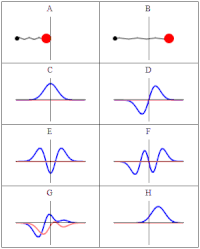
Photo from wikipedia
We present a quantum dynamics approach for molecular systems based on wave function factorization into components describing the light and heavy particles, such as electrons and nuclei. The dynamics of… Click to show full abstract
We present a quantum dynamics approach for molecular systems based on wave function factorization into components describing the light and heavy particles, such as electrons and nuclei. The dynamics of the nuclear subsystem can be viewed as motion of the trajectories defined in the nuclear subspace, evolving according to the average nuclear momentum of the full wave function. The probability density flow between the nuclear and electronic subsystems is facilitated by the imaginary potential, derived to ensure a physically meaningful normalization of the electronic wave function for each configuration of the nuclei, and conservation of the probability density associated with each trajectory in the Lagrangian frame of reference. The imaginary potential, defined in the nuclear subspace, depends on the momentum variance in the nuclear coordinates averaged over the electronic component of the wave function. An effective real potential, driving the dynamics of the nuclear subsystem, is defined to minimize motion of the electronic wave function in the nuclear degrees of freedom. Illustration and the analysis of the formalism are given for a two-dimensional model system of vibrationally nonadiabatic dynamics.
Journal Title: Journal of chemical theory and computation
Year Published: 2023
Link to full text (if available)
Share on Social Media: Sign Up to like & get
recommendations!